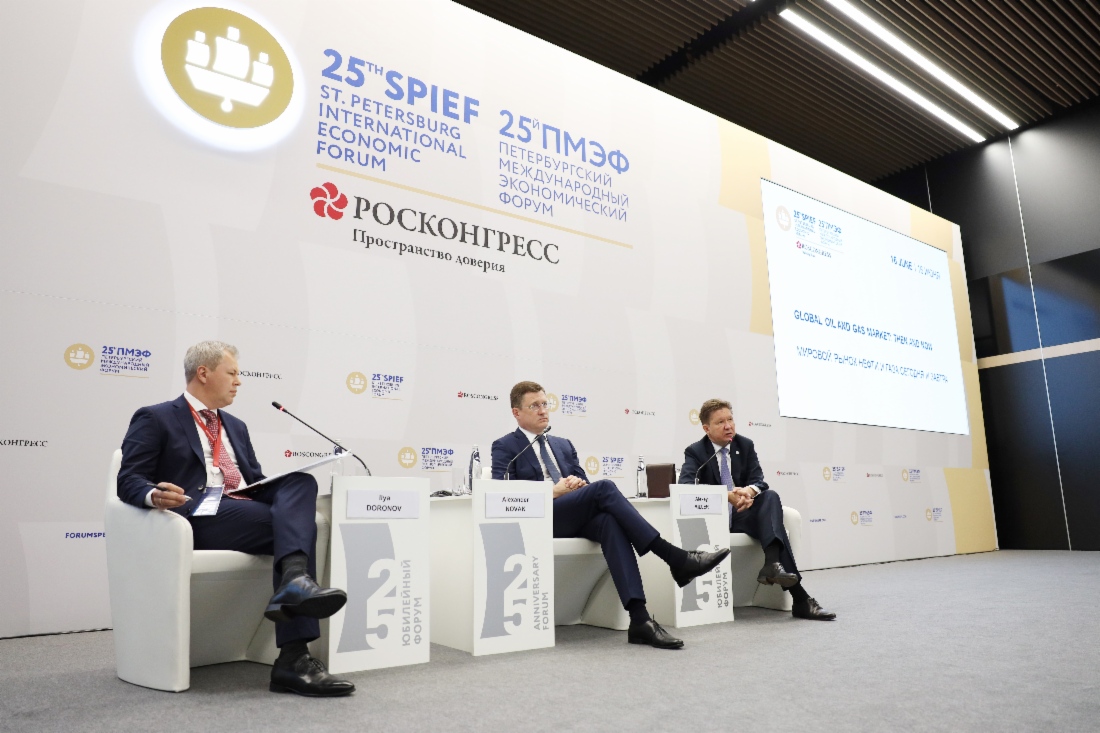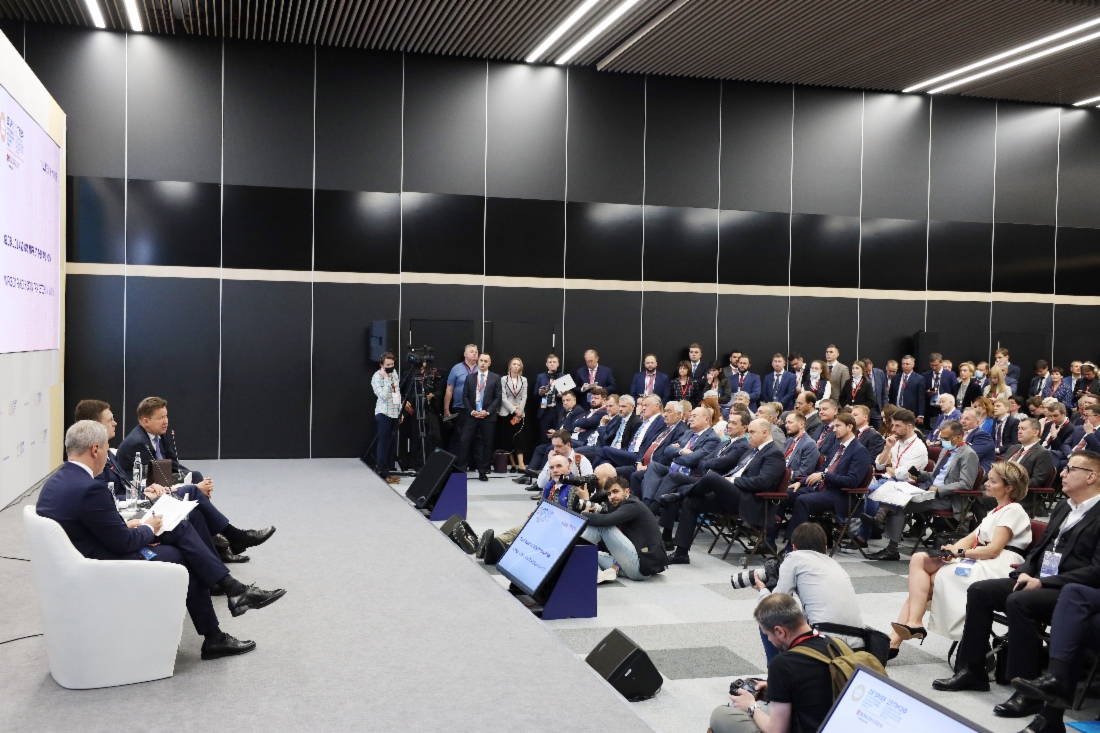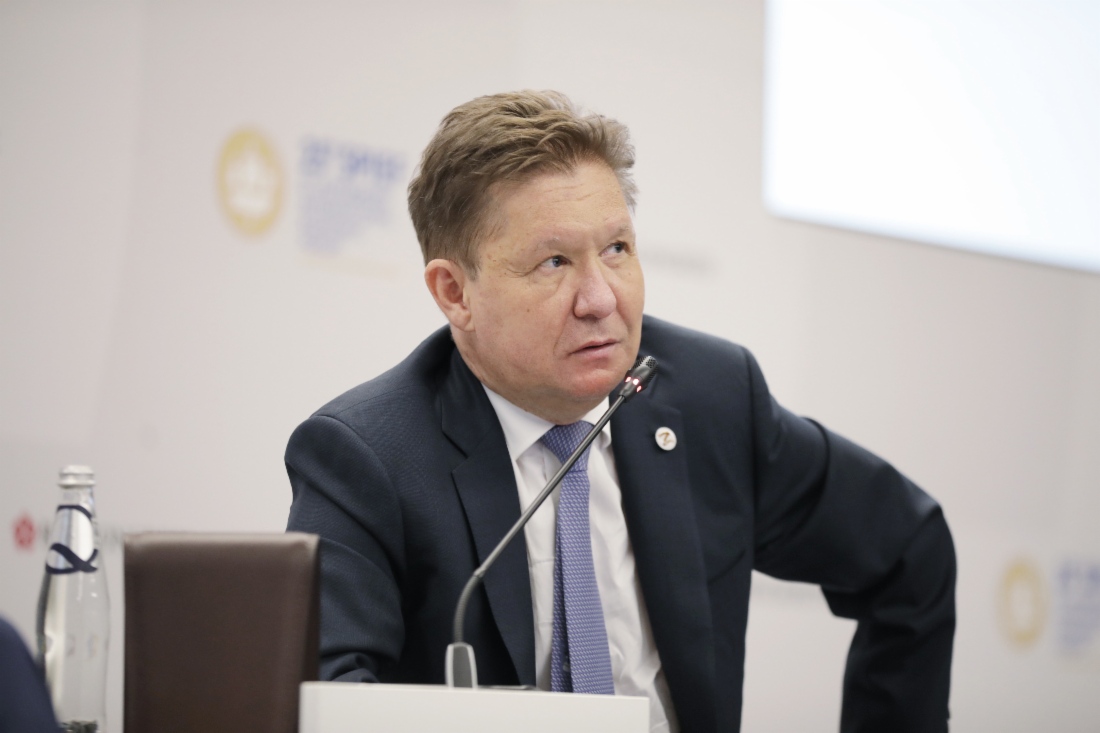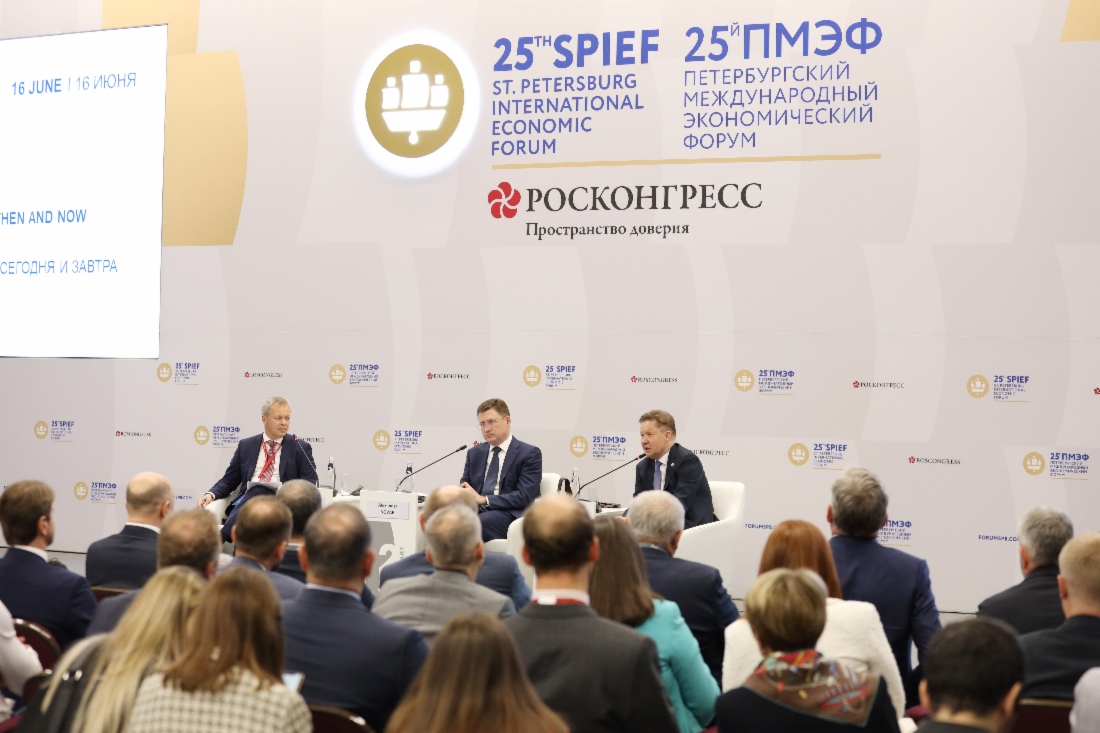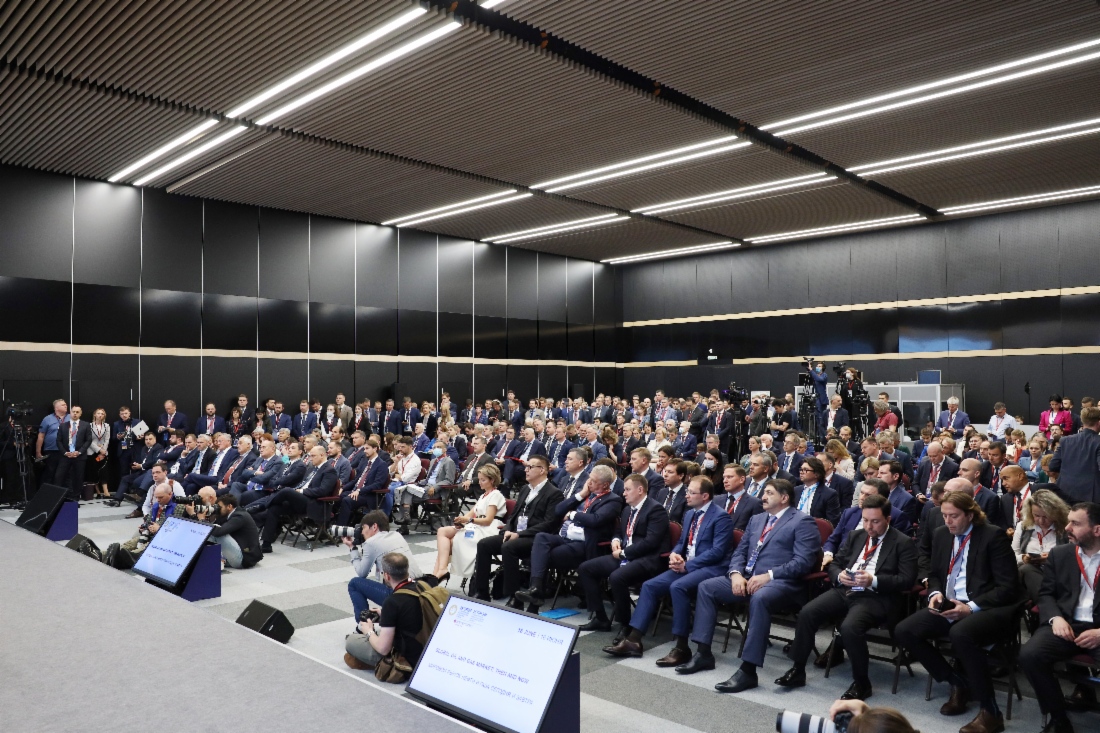Speech by Alexey Miller at “Global Oil and Gas Market: Then and Now” Panel Session
St. Petersburg
Esteemed colleagues, dear friends,
I am happy to welcome you at the St. Petersburg International Economic Forum! Today, I would like to touch upon a number of very important, fundamental issues. I think all of you will agree that we are witnessing very serious, tectonic changes that take place in commodity markets. And most importantly, economic paradigms are changing.
For instance, the Bretton Woods II system is waning. We see gas price shocks, we see ultra-high volatility in commodity markets and very high inflation. But all of this started not yesterday and not today. And here one has to say “a big thank you,” in air quotes, to foreign regulators, namely, European ones.
It has been a long time since we last heard that nice phrase – “Third Energy Package”... Let us look back at the Third Energy Package today. What was that? And where did it actually get us? Or, speaking about the effect of the Third Energy Package on our consumers, where did it get them?
Firstly. “Under the Third Energy Package, let us do away with oil-indexed prices for gas, let us break the connection to oil prices.” Excellent. These efforts were commenced under the guidance of European regulators. What do we see today? Today, everyone would like to have oil-pegged supplies of gas under their contracts. Because it means the lowest gas prices.
Next. “Let us do away with long-term contracts. Why use these long-term contracts of yours? Let us switch to spot trading. Let us switch to stock exchange instruments. And it’s the market – the spot and stock exchange market – that will put everything in its proper place.”
However, as we know, our Company does not create production capacities, does not produce or transmit gas before gas is sold. That is why today we, in our turn, can please our regulators by saying that no production capacities are available or are being created to serve the existing long-term contracts that have not been extended or new contracts that have not been concluded. Thus, the gas sector is subject to underinvestment, to potential underinvestment.
As regards spot trading and stock exchange instruments, we actually warned against them and said: “Why do this, considering that gas, unlike oil, is not among traditional exchange-traded goods?” The result is that all of those spot and exchange platforms are ineffective.
MODERATOR: What answers did you get when you said that?
ALEXEY MILLER: They just did whatever they thought necessary. But, as you know, a famous emperor once said: “Never interrupt your enemy – in our case, let us say ‘opponent’ – when he is making a mistake.” But we warned them. We said: “It’s exceptionally risky to stop using long-term contracts.”
Next. Nord Stream 2. We built Nord Stream 2 exactly the same way as we built Nord Stream 1. First of all, we have to get an essential thing called “a request.” The point is that we are asked to perform these works. It is not that we start building infrastructure projects of this kind at our own initiative and then say: “Hi, we are at the coastline, our pipe is here already.” Of course not.
We were asked to build it. The investments were immense. And now, when all construction works are completed – as you know, the two strings of Nord Stream 2 are under pressure and gas supplies to Germany can be started as soon as today – the pipeline is not launched because it is not certified. In this case, a question arises: “How can one have any trust at all when it comes to financing investment projects, in particular, large-scale investment projects?” There are tougher ways to put it: this is discrimination against investors.
That is why, if we speak about inflation and volatility of prices, they stem from the decisions that were announced and put into practice. Well, they got the result and they have to accept it. They got what they fought for.
And what do inflation and price volatility create? They create demand for loans. In particular, short-term loans. But this creates the need for banks to increase their volatility. And we already see that some foreign banks experience certain difficulties providing such loans. Maybe, after a while, they will no longer have this possibility at all, considering such volatility and such price shocks.
What are we witnessing now? We are witnessing two systems being torn apart. On the one hand, the system of commodity markets – the resource system. On the other hand, the system we can call nominal – the system of Central Banks, the reserve system.
What is the problem and what are the signs of these systems being torn apart? And these signs do not emerge just because someone is blaming someone. They exist just as a given fact.
Central Banks regulate the nominal value. They regulate interest rates. They regulate currency exchange rates. But all of these things are nominal. All of this is nominal. They use these nominal instruments – I’d like to draw your attention to this point as it is a very important one – to manage and control demand.
But what is beyond their control? It is the supply in commodity markets. Supply of raw materials. And the scope of such supply. They just don’t have any instruments to control that. And the Bretton Woods II system is actually a paradigm: “Our currency – our rules; we tell you how you can use our currency, what we allow and don’t allow you to do. And the law is the Atlantic anyway.”
But we see that the dominating position of the dollar is receding. Settlements in national currencies start taking place. And, ultimately, the paradigm is changing.
If we recall the traditional scheme of “money – commodity – money and apostrophe,” which is the Bretton Woods paradigm, we will see that a completely different formula is taking center stage today: “commodity – money – commodity.” Sell gas first and then produce it. Our commodity – our rules. We do not play games the rules of which were not created by us. Someone says: “The law is the Atlantic.” And someone says: “The law is the taiga.”
What is most interesting is that the sanctions policy and the counter-sanctions policy have brought about the consequences that no one might have expected. Why? Because sanctions and counter-sanctions have affected the global commodity markets.
We’re all well familiar with the notion of quantum entanglement in quantum physics. Similarly, one can say that the global economy today is subject to sanctions-related and quasi-sanctions-related entanglement. Tens of thousands of documents regarding sanctions and counter-sanctions. It should be noted that the first round of sanctions might get followed by a second one, a third one, and so on.
What does that mean? It means that, apparently, the so-called extraterritorial law stretches beyond the Bretton Woods paradigm that goes, “our currency – our rules.” And it can be observed in another paradigm. Why? Because you can’t describe the state of your energy system or your economy without knowing the rules of a given commodity market or the scope of supply in that market. When that happens, the Bretton Woods system and the global international institutions simply lose all meaning. They lose meaning. They stop working. And they quietly die out.
You know, no one ever said that the apocalypse for a paradigm or a system happens in a day. Remember that joke about a guy who goes to see famous surgeons about his leg? The first surgeon says: “We need to amputate it as soon as possible.” The second one goes: “The sooner the better.” The third one agrees: “It’s urgent.” But the guy resists. He comes to a physician and says: “Could you take a look at my leg? All surgeons are saying I must cut it off.” The physician replies: “No, you really don’t have to.” “How so? Those celebrated surgeons said I must.” “Don’t worry, it’s going to fall off by itself.”
And just like that, all these global international institutions of the Bretton Woods system are slowly withering and falling away. We are no longer feeling their influence. They no longer understand their role either and, I stress, the meaning is lost. It’s meaningless.
Speaking of Bretton Woods and the topics we discussed previously, this system of nominal regulation of cost in isolation from potential control over commodity supply generates a huge inflationary impulse. The system works like that. This huge inflationary impulse isn’t caused by a single person named Ivanov or Petrov or Sidorov or Smith but by the Bretton Woods system itself.
That’s it. What happens next? Deglobalization, accumulation of commodity stocks, and overlapping supply chains. At the end of the day, we realize that, as some experts say, “The game is over.” Although we’re actively trying to avoid English loan words, the English phrase “The game is over” is fitting here. Why is the game over? Because the demand for feedstock is replacing the demand for currency reserves. This is a major tectonic shift. A colossal one.
The question is: what does that give us? Firstly, it gives us a window of opportunity from the viewpoint of rebuilding the global production system and distributing fuel and energy resources to make energy supply more efficient and fair.
Many experts say that it’s time to create new energy and economic associations that could be built on, for instance, a common value chain in the fuel and energy complex taking production cycles into account. Crucially, they should be firmly oriented towards a specific amount of consumption. Some experts go even further, saying that these associations could be built on a triad: energy and feedstock, food supply, and military potential.
As we know, Russia is very rich in natural resources. Natural riches are about us. What does it mean? It means that the societal and economic structure of the new type will be shaped by the Russian Federation to a large degree. There is no doubt about that.
What is happening in the markets? Let’s talk about the past few years. After all, the market environment is changing very fast, and the real situation in the markets cannot be described even by the figures that are mentioned in the talks about gas being injected into UGS facilities throughout the past ten or even five years. We need to look at the figures from the last few years.
The period from 2018 to 2021. If we talk about Gazprom, the Company passed that very difficult period successfully. It was a period of skyrocketing and plummeting gas demand. A period of limited mobility and post-COVID rehabilitation. Last year, in 2021, a third of growth in the global demand for natural gas was covered by Gazprom’s production capacities.
In these conditions, which are undoubtedly fundamental and are here for the long term, we also see positive changes in the domestic market.
Because this leads to increased activity for creating gas-intensive production capacities – small-, medium- and large-scale ones – in the areas of gas processing and gas chemistry. The most important thing, however, is the goal set by Vladimir Putin, President of the Russian Federation, to complete nationwide gas infrastructure expansion. All 100 per cent of technically possible connections to the gas grid in Russia will be achieved by 2030. Needless to say, this also means chemical fertilizer production. It also means wider use of gas as a vehicle fuel.
If we talk about additional gas supplies under the Program for gas infrastructure expansion, they will amount to about 20 billion cubic meters of gas by 2030. As for gas as a vehicle fuel, that’s about 10 billion cubic meters additionally.
Speaking of the domestic market, it is imperative to touch upon the Eastern Gas Program. Basically, the development and execution of the Eastern Gas Program didn’t start just yesterday. We started it much earlier. But we’re already going faster. Very soon, we’ll accelerate the Eastern Gas Program even further.
I’ll remind you of some enormous megaprojects. Sakhalin – Khabarovsk – Vladivostok. Power of Siberia. I’d like to single out a new contract that was signed in February this year to supply 10 billion cubic meters of gas annually to the People’s Republic of China from Russia’s Far East. We’ve begun the front-end engineering design for the construction of an interconnector between the Unified Gas Supply System in the European part of our country and Eastern Siberia along with the Far East. The Power of Siberia 2 gas pipeline. And so on and on and on.
The crucial thing is that the prices in the domestic market – Russia – are entirely stable, predictable and socially oriented. It should also be noted that our gas is contributing and will keep contributing even more to the growing competitiveness of the prime cost of our industrial products.
The European Union. Everyone is talking about the Portovaya compressor station. What is the Portovaya compressor station and what is going on with it? We’ve touched upon the sanctions-related entanglement. This is either that or somebody’s completely purposeful decision.
It’s a very challenging situation. Essentially, when we were building Nord Stream 1 and Nord Stream 2, but especially Nord Stream 1, everybody was proud of the trans-European – indeed, trans-European – scale and format of this project. Dozens of European countries were mentioned for their contribution to equipment supplies for the construction of Nord Stream 1.
And as on the part of Germany a number of German companies are shareholders in Nord Stream 1, this means that a significant amount of equipment supplies and German companies have been part of this project. Take, for instance, Germany’s Siemens. So, today all these gas compressor units, all these gas turbine engines are produced by Siemens. However. As we know, every gas turbine engine has a set time between overhauls. After this time expires, the engine undergoes an overhaul. Mind you, this means major repairs. These have to be done in a factory environment. Apparently, Siemens only has one factory to repair these engines. It is based in Canada.
Excellent. Going back to the sanctions-related entanglement and the question of its purposefulness. As you know, the only country that has imposed sanctions against Gazprom is Canada. Canada? We do not work in Canada. What does Canada have to do with it? Still, Canada has sanctioned Gazprom.
Siemens, which is our partner whereas the Canadian factory is not, brought the engine to the factory and is unable to get it back. Siemens – not us but Siemens – is told: “Sorry, we have our own law in Canada, we have sanctions law. What international law? Sanctions law. Gazprom is under sanctions. You didn’t sanction them but we did. You have a factory here. Interesting. You have a turbine that you own and must deliver. Interesting. But it’s impossible under sanctions. Impossible.” What to do? Canada says: “We do not know. It is impossible due to sanctions. Go away.”
It gets worse. The engine is still at the factory. Siemens cannot retrieve it. Meanwhile, the overhaul time is running out for other engines – not all of them, there are some left. They cannot be sent to Canada. Or to another factory elsewhere.
Then we ask: “Did this happen because of some sanctions-related entanglement?” Or it might have happened because there is an answer to the question: “Why did this happen?”
If that question has an answer, the purpose of the sanctions might be much more global and spread out. It might be useful to consider how and by whose hands this is done.
I can tell you right now in clear terms: there is no solution to the problem of the Portovaya compressor station at the moment. So far no solution, you see. Siemens remains silent for now. They are looking for solutions. There are none.
Of course, Gazprom is reducing its gas supplies to Europe. Yesterday, we published the stats for the first five and a half months. Indeed, our gas supplies to Europe have dropped by tens of percentage points. But as you know, prices have skyrocketed several times over as opposed to tens of percentage points. So forgive me when I say with all sincerity that we hold no grudge against anyone. No grudge, truly.
As for the European Union, some issues need to be raised. We have talked about the Portovaya CS, the regulators, and Nord Stream 1. Let us also discuss Nord Stream 2 considering what has happened. Nord Stream 2 stands idle. However, as you know, the Russian economy and domestic market do not stand still.
We realize that we have created excess capacities for the Nord Stream 2 gas pipeline which is not being used. So what? For now, we have repurposed the capacities of one string of Nord Stream 2 to serve the gas supply needs of the Northwestern Federal District.
All governors in the Northwestern Federal District applauded us and said: “Amazing job! We will build gas infrastructure faster than ever, and our new production facilities will be something to behold!”
Next. To be honest, we have questions regarding the way decisions are often made. For instance, the proposition of which the audience here is well aware: to bring some floating regasification units into European ports and leave them there. As you know, bringing a regasification unit to a large port in a very densely populated area is an exceedingly bold decision indeed. Very bold.
That said, a regasification unit by itself is like a glass without water. Not just without water – without gas. Fine, so you bring those units there for some reason. What about buying liquefied natural gas? What about contracts to keep these regasification units loaded? What are you going to put in that glass? No answer.
We can say with certainty that in the very near future the demand for LNG is going to grow in the Asia-Pacific region. It’s going to grow substantially. Will we see European importers of LNG fighting over additional supplies of the “golden” LNG with Chinese, Indian and Asian buyers as soon as by the second half of this year?
We cannot rule that out. It is absolutely certain that LNG demand is going to grow there very soon. We know which factors made demand go down temporarily. Now their influence is subsiding.
Next. Here is a very telling example of solutions that are being proposed there. They are saying in Europe: “Oh! You know what, we are going to increase biomethane production in the short term by 17 billion cubic meters of gas.”
As you can imagine, 17 billion cubic meters of gas for Europe and for Russia is... just that. In the short term.
Today, there are over a thousand – 1,023 – factories for biomethane production in Europe. They produce less than 3 billion cubic meters of gas in total. It took them 10 years to create these capacities.
So, if they keep up that pace, it means that they will need 60 years and 5,700 factories to increase biomethane production by 17 billion cubic meters. I think we can use an analogy here: the mountain may give birth to a mouse. Absolutely.
They make extremely hasty decisions at times. They make them very quickly, sometimes without thinking them through. As people say, a word spoken is past recalling. We’ve already talked about long-term contracts today. We were told that there was no need for long-term contracts – that was it. Fine, no need. Fine, there will be none.
On our part, we’ll fulfill our obligations, we’ve listened. Will the other party be able to fulfill its obligations? When it comes to biomethane or floating regasification units or whatever else. There is also the topic of wind farm islands, which is too large to touch upon here.
As for the year 2021. What countries showed the highest demand for gas? China and India, of course. In the last 10 years, from 2011 to 2021, China’s gas demand was responsible for – get this – 32 per cent of growth in the global demand for natural gas. In the last five years, from 2016, the average annual growth in China’s gas consumption has been 32 billion cubic meters. In late 2021, the share of gas in China’s energy mix stood at 8.5 per cent. Their goal is to reach 15 per cent by 2030. I have no doubt that they will reach it.
As a possible conclusion, let’s talk about the latest operational figures for the past five months. Global gas consumption in the first five months of 2022 decreased by 25 billion cubic meters compared to the same period of 2021. Question: by which amount did gas consumption decrease in the 27 countries of the European Union through that period? Answer: by 24 billion cubic meters. On the other hand, Gazprom ramped up its pipeline gas supplies to China by 67.5 per cent in the five months of 2022 compared to the same period of last year.
Let’s talk about the medium-term perspective. The medium-term perspective is essentially a single investment cycle of five years. In the gas industry, this is a completely workable figure, a completely workable term.
The pessimistic forecast for global gas consumption growth – the negative one – envisages a growth of 320 billion cubic meters. The average forecast predicts a growth of 370 billion cubic meters. Please note that – everyone in this room knows this – a lot more production capacities will need to be created due to dwindling production at the active fields. This is why the gas industry will have a very substantial amount of serious and ambitious work to do in the next five years.
Russia stands for energy stability. Moreover, Russia is the supplier of energy stability for the friends of Russia.
Thank you!
MODERATOR: All I can say after this is: “Phew!” Mr. Miller, I can imagine today’s headlines everywhere saying: “Game Is Over.”
To clarify: what game was that and why did it have to be over?
ALEXEY MILLER: I’ll tell you again.
Firstly, about the kind of game that was. We’re talking about the Bretton Woods II system. Secondly, we’re saying that the demand for currency reserves is replacing the demand for feedstock. So the game with the nominal value of money is over. The nominal value instruments game is over. This system makes it impossible to control supply for a resource. It makes it impossible to control supply in commodity markets. Nominal value instruments – interest rates, exchange rates – make it impossible. Meanwhile, the role and share of feedstock and energy keep growing. Energy and feedstock are essential.
MODERATOR: Thank you!


